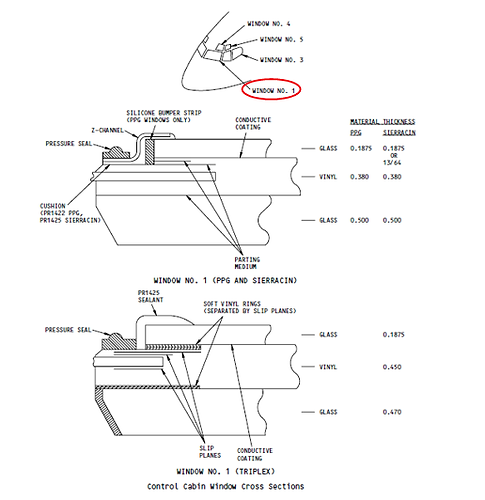
WINDOW CONTROL 1
Location (IPC 235-1)
Item: 30
Part Number: 83000-05601, 231-2
Station: 353
Zone: 205
Rack: E3-3
Ata: 30
Sub-Ata: 30-41-00
ICE & RAIN PROTECTION
Description (AMM 30-41-00)
A- The windshields are of laminated construction. They are designed to withstand bird impact with or without window heat.
B- Number 1 windows from three different manufacturers can be installed. These manufacturers are PPG, Triplex, and Sierracin. These windows are completely interchangeable regardless of the manufacturer. Windows by different manufacturers may be mixed on the airplane. Subtle differences in the windows may be noticed.
C- The construction of window No. 1 consists of a glass pane laminated to each side of a polyvinyl butyral (vinyl) interlayer or core (Fig. 1). The inner glass pane is the thicker of the two and is the primary load carrying member. The vinyl interlayer, or core, acts as the "fail-safe" load carrying member and prevents the window from shattering if the inner pane should break. The outer pane has no structural significance, but provides rigidity and a hard, scratch resistant surface.
D- The different layers of the windows expand and contract at different rates during a change in temperature. This can cause the layers to pull against each other at their interface with great force causing internal glass chipping and vinyl interlayer cracking, especially around the edges. To prevent this windows have thin layers of a slippery material around the edges, called parting material or slip planes, to allow the window layers to slide against each other during expansion and contraction. Some windows have soft material layers around the edges or across the whole window that will flex when the main structural layers pull against them.
E- A conductive film, applied on the inner face of the outer glass pane permits electrical heating for anti-icing and defogging. Bus bars molded into the upper and lower edges of the windows in contact with the conductive film are connected to electrical terminals. For further information concerning window anti-icing and defogging refer to Chapter 30, Control Cabin Window Anti-Icing System.

